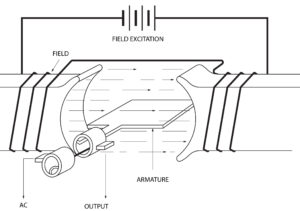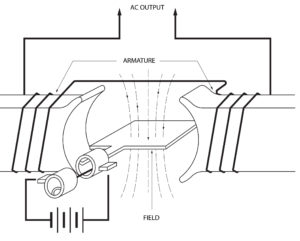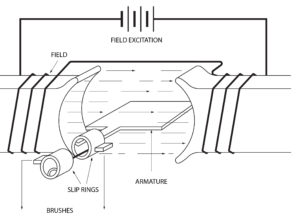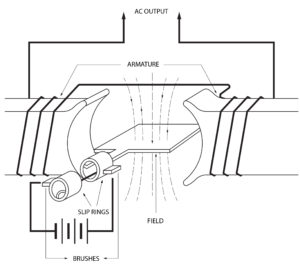AC Generation
The Alternator
How do we keep the voltage coming?
We have established that if we have a conductor pass through a field or a field through a conductor a voltage is established. This means that voltage is only established when there is constant motion. Instead of having someone passing a conductor through a field rapidly, it was discovered that the conductor could be formed into a loop and rotated through the field to maintain a voltage. This would be an example of what is known as a simple alternator.
A simple alternator has two magnetic poles that establish a magnetic field. The conductor (armature) rotates through this field to establish a voltage.

A practical alternator has a stationary conductor and the field rotates.

What are the parts of the alternator?


Armature. This part is what the voltage is induced on to. It can be rotating (simple alternator) or stationary (practical alternator).
Slip rings. Made of brass, they rotate and either bring current to the load (simple alternator) or excitation to the field (practical alternator).
Brushes. Made of graphite carbon, they are stationary and either pass current to the load (simple alternator) or current to the field (practical alternator).
Field poles. They are either stationary (simple alternator) or rotating (practical alternator).
Prime mover. This part spins the armature (simple) or the field (practical). Examples include:
- combustion engine
- hydro dam
- hand crank
- windmill
Which is better the simple or the practical?
If you guessed the practical, you would be right. The brushes of a simple alternator have to be sized for the load. If you have a large load that draws a lot of current, then your brushes would have to be sized accordingly. Whereas, with the practical alternator the brushes bring current to the field and can be small yet still allow enough current to adjust the field. With either alternator, the easiest way to adjust the voltage is by varying the field strength. It is possible to vary the speed on the alternator to adjust the voltage, but this will also change the frequency.
Next up: How an alternator creates a sine wave

